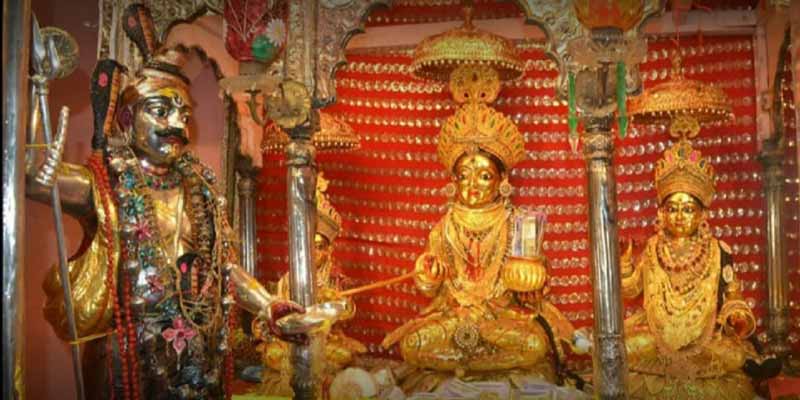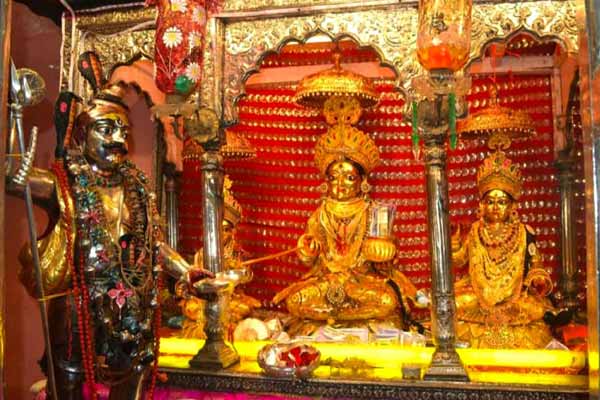Annapurna Temple Varanasi is one of the most beautiful temples in Varanasi located near Kashi Vishwanath Temple . The deity here named Annapurna Devi is said to be an incarnation of the popular Hindu Goddess Parvati. This is the temple where you would see Goddess Annapurna being worshipped as the provider of food. Then, in AD 1729, Maratha Peshwa Baji Rao constructed this temple that is in the Nagara style architecture Annapurna Temple Varanasi.
There are two idols of the goddess in this temple. One idol is made up of gold while the other idol is made up of brass. The brass isol can be seen on any day whenever you plan to visit but to get the darshan of Gold deity you have to plan your visit on the day before Diwali.
This day is famous by the name of Annakut day. This is the day when the devotees and visitors can look at the gold idol each year. Timings: The temple stays open from 04.00 am to 10.30 pm; every day. Book Tour Package to Maa Annapurna Temple Varanasi Tour Packages.

History of the Goddess Annapurna
Once, Lord Shiva said to the Goddess Parvati that the whole world is an illusion and the food is the part of that known as ‘Maya’. The Goddess of food (Mata Parvati) became very angry and She had to show the importance of all the material, in order to that She had vanished all things from the world. In the absence of food from the earth, the earth became infertile and everyone had suffered from the deep hunger Varanasi Attractions.
She had to reappear in the world by seeing His devotees suffering from the deep hunger. She, then made a kitchen in the holy city, Varanasi. Lord Shiva too came to Her and said that I understand that the material can never be sent away as an illusion. Mata Parvati became very happy and offered food to the Lord Shiva with her own hands. From that time Mata Parvati is worshiped as an Annapurna means the Goddess of Food.
Another myth about the Annapurna is, Once Mata Parvathi had closed all the eyes of the Lord Shiva (three eyes: Sun, Moon and Fire) and entire world was full of darkness. There was the condition of ‘Pralaya’ and the color of the Mata Parvati became dark also (means She has lost Her Gauri Rupa). She was very sorrow and asked Lord Shiva how to get Gauri Rupa again. Lord Shiva said to Her to make Anna Dan in the Kashi. Mata Parvati took Her Annapurna Rupa with a golden pot and ladle and made Anna Dan in Varanasi. Again She got Her Gauri Rupa. It is considered that Her devotees do Annapurna Pooja by making Anna Dan in Kashi.
There are various names of the Mata Parvati worshipped by Her devotees all over the world. The Annapurna Shatanama Stotram has 108 names and The Annapurna Sahasranam presents one thousand names of the Annapurna Mata.
It is considered that She does not eat a little bit till the time Her devotees have not been fed in Her temple. The Annapurna Vrat Katha has various stories and helps Her devotees to get rid of their problems. Annapurna temple in Varanasi is situated adjacent to the Kashi Viswanath temple. Annapurna Mata is considered as the queen of the Kashi and Lord Shiva is considered as the king of the kashi. In the temple of the Mata Annapurna, in the noon time food as a ‘Prasad’ is offered to all the old, disabled and other devotees daily Annapurna Temple Varanasi.
Art and Architecture:
Nagara-style architecture is used in the construction of Annapurna Devi Mandir. There are two statues of the goddess Annapurna Devi in the temple’s sanctum, one made of gold and the other of brass. The gold idol can only be seen once a year on Annakut Day, although darshan of the brass idol is possible every day. Every year, following Diwali, the Annakut festival is observed. Coins are given out to all the worshippers on this day. Whoever worships this currency is said to receive Annapurna Mata’s blessings for a fruitful and wealthy life. The sanctum of this temple features a sizable porch with pillars that depicts Annapurna Temple Varanasi.
Maa Annapurna Story:
An aspect of Devi Adishakti, Annapurna, Annapurneshwari, Annada, or Annapoorna is referred to be the Hindu Goddess of food and nourishment. The Goddess Annapurna is recognised as a popular divinity since Hinduism highly values worship and food offerings. Annada Mangal, a narrative poem in Bengali by Bharatchandra Ray, beautifully describes her as a manifestation of the Goddess Parvati, the husband of Shiva. Mata Annapurna is known by various names among her devotees throughout the world. The Annapurna Shatanama Stotram contains 108 names, while the Annapurna Sahasranama contains 1 thousand Annapurna names.
There are a few temples that are dedicated to her, with the “Annapurna Devi Mandir” in Kashi being the most well-known. The day “Akshaya Tritiya” is seen to be extremely fortunate for purchasing gold jewellery because it is thought to be the Goddess Annapurna’s birthdate. In India, Akshaya Tritiya is often observed in late April or early May.
It is believed that Mount Annapurna in the Himalayas is named after her as the goddess is believed to be one of the daughters of Himavat, the king of the mountains. The Western world names her the “Hindu God of Cooking,” considering her association with food items Annapurna Temple Varanasi.
The name Annapurna, which means “the provider of sustenance and nourishment,” is borrowed from Sanskrit. The Greek words for “meal” or “grains” are anna () and “full, complete, and perfect”. Because the goddess is thought to be one of Himavat, the ruler of the mountains, or one of his daughters, Mount Annapurna in the Himalayas is thought to have been given her name. She is known as the “Hindu God of Cooking” in the West due to her connection to food.
How to reach the Annapurna Temple :
Anyone can take an auto from Varanasi Cantt Railway Station to Kashi Vishwanath. Later walk to temple enjoying serpentine lanes of Varanasi City.
By Road : Varanasi has a very good network of roads. There is always frequent public and private buses and road transport to all the major towns of Uttar Pradesh and nearby areas.
By Rail: There are two railway stations in Varanasi, the Kashi Junction and the Varanasi Junction (also known as Varanasi Cantonment). Devotees have facility of trains from Mughalsarai, just 10 km south of Annapurna Temple Varanasi.
By Air : One can reach the temple as Varanasi is well connected and accessible to major Indian cities and tourist spots. There are daily domestic flights to and from Varanasi to several cities in India.
